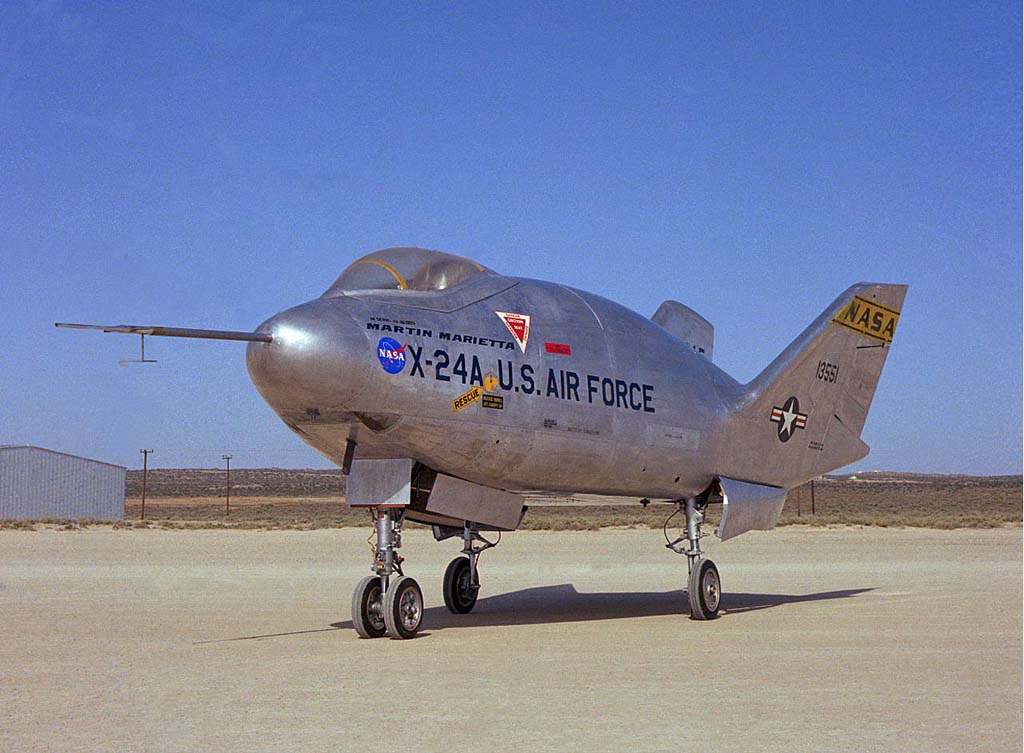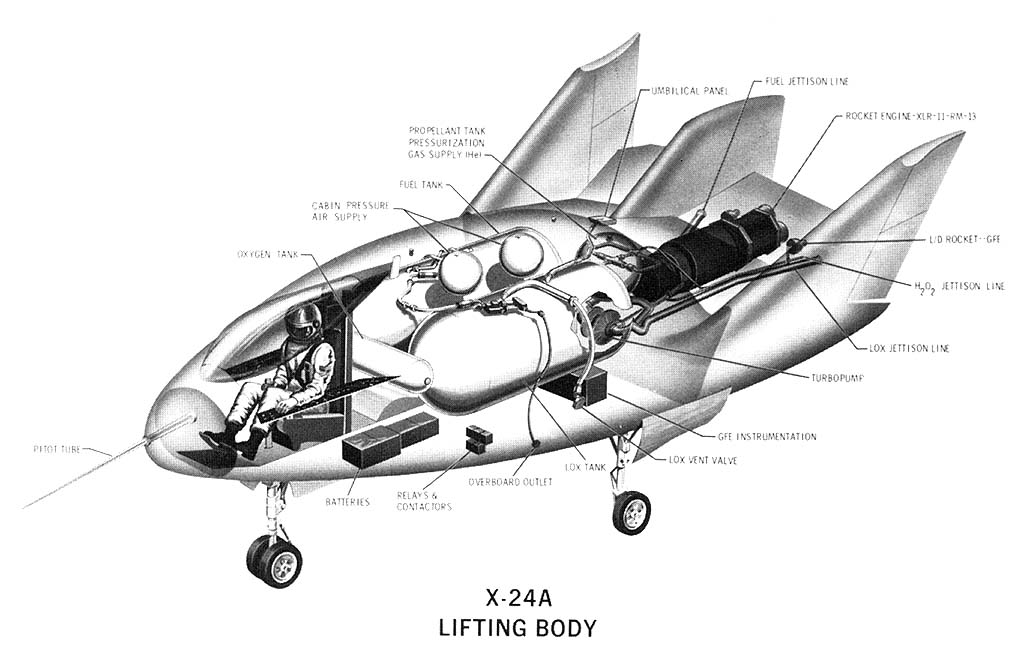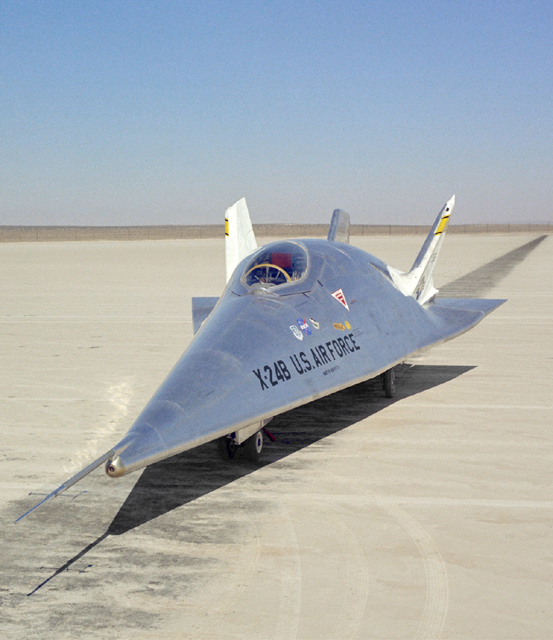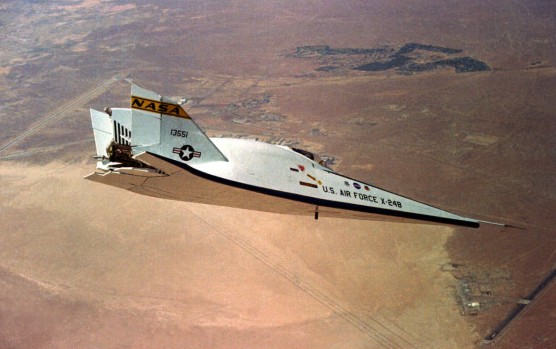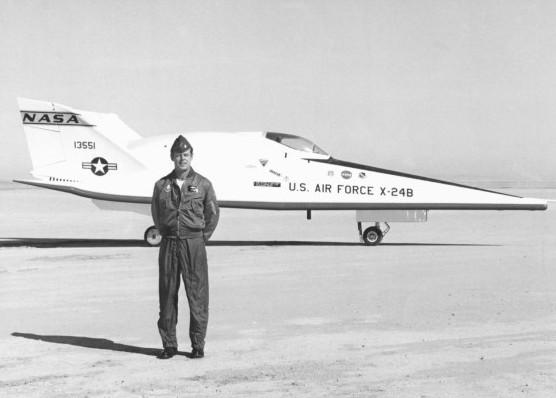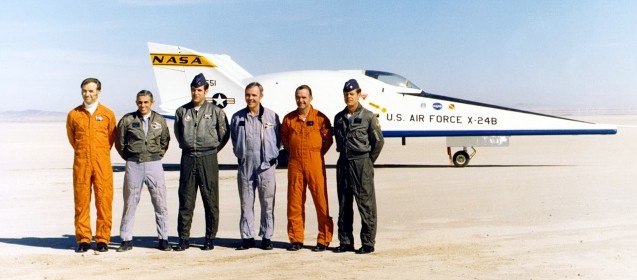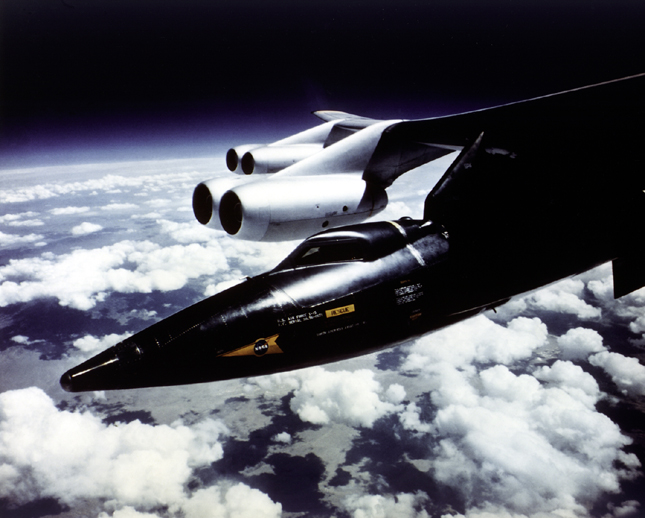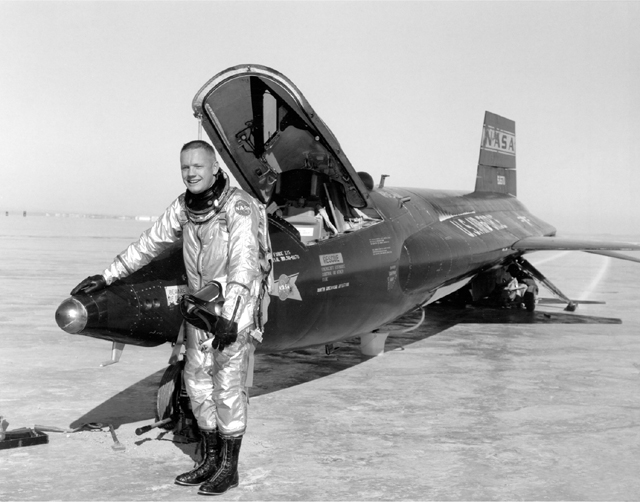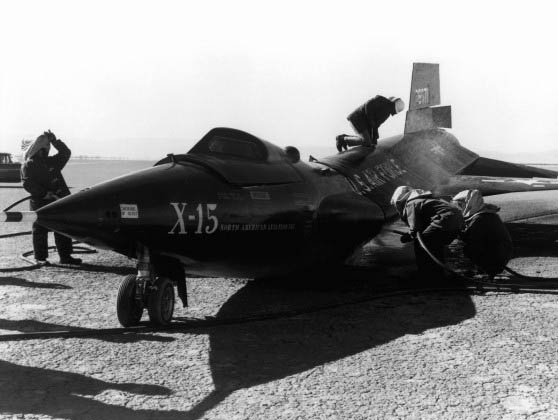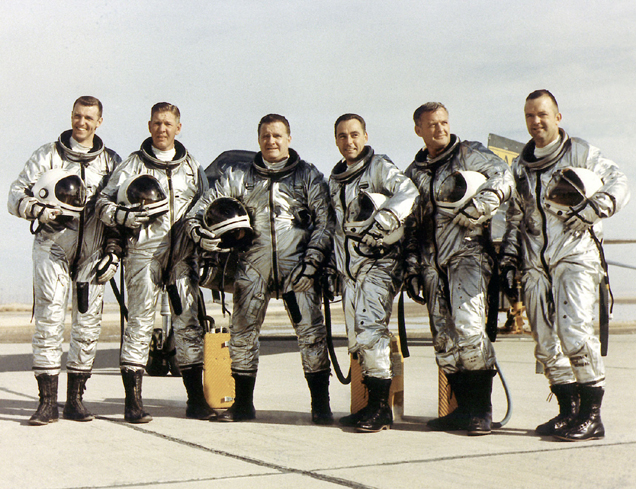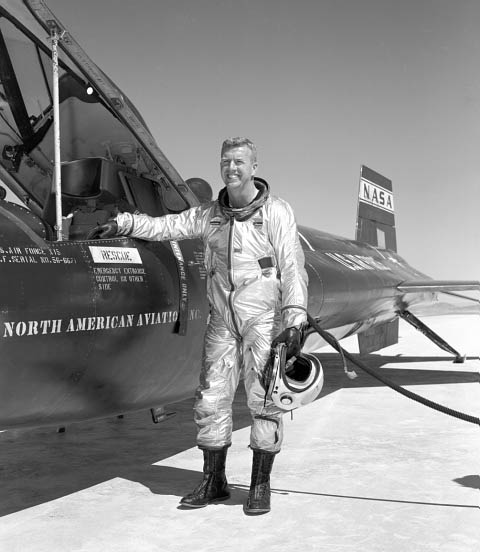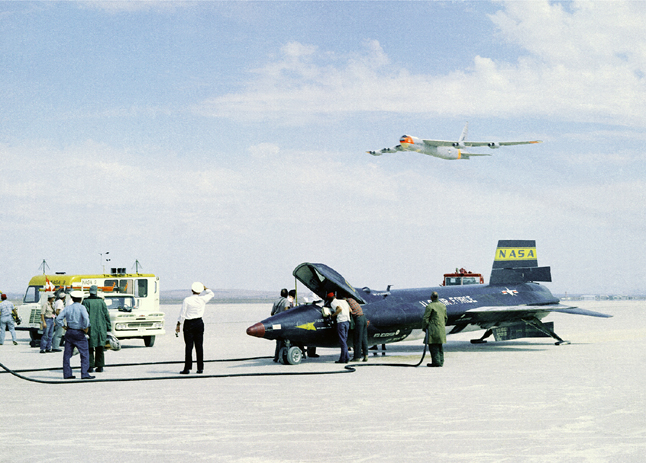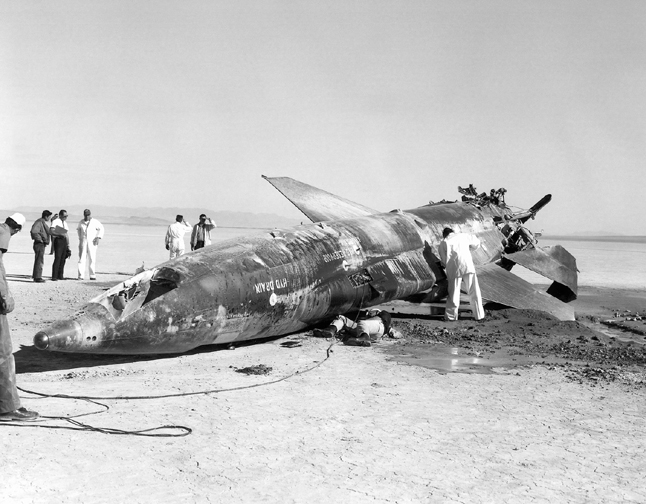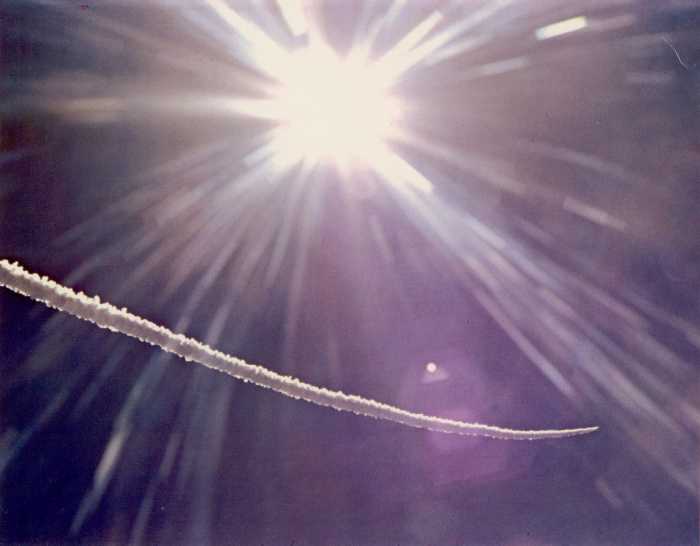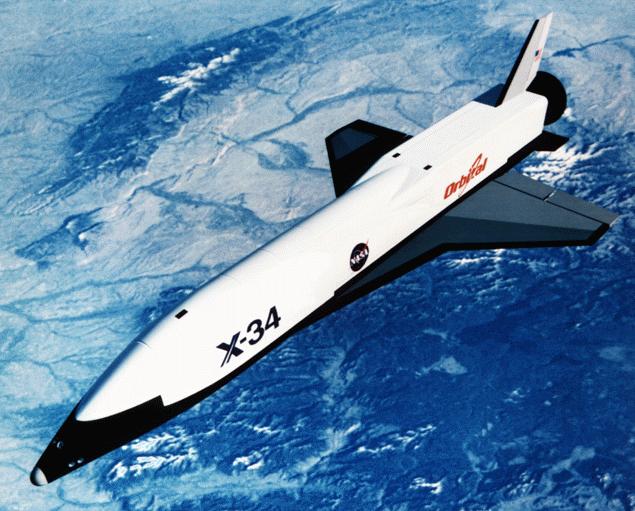| SECRET
SPACE SHIPS
The X Planes |
||||||||
|
.
The Prime (Precision Recovery Including Manoeuvring Entry) project was the second part of the USAF START program. The purpose of START was to develop and demonstrate the technology for manoeuvring lifting-body re-entry vehicles with a cross range of up to 1100 km. Planned applications included ICBM warheads, reconnaissance satellite film recovery capsules, and manned spacecraft. The X-23 Prime was a subscale re-entry test vehicle of the SV-5D lifting body configuration planned for the X-24A manned aerodynamic test aircraft. In three suborbital launches the robot vehicle demonstrated the full planned cross range manoeuvre, and the problems involved in using spray-on ablative heat shields. Martin-Marietta X-23A Description
Specifications
Propulsion
|
||||||||
|
.
Submitted by Guy E. Franklin, Montgomery Alabama USA The Martin-Marietta X-24A. By the 1960s, Martin-Marietta (as the Martin company, builders of the PBM Mariner flying boats and B-26 Marauder bombers during WWII) were basically into building missiles such as the Titan II. The X-24A was designed as an investigation of the "shuttlecock" stability concept, a theory which could provide stability for re-entry vehicles as they slowed from orbital speeds to landing speeds. The body flaps, fins, and control surfaces would all contribute to this configuration as they deployed and operated, rather like the "tailfeathers" of a shuttlecock. Initially designated the SV-5P, he shape of the X-24A was closely based on that of the SV-5D/X-23 PRIME unmanned lifting body article, launched atop rockets from Vandenberg AFB, CA a couple of years earlier.
Cutaway illustration of the X-24A. Most rocket planes had an internal
configuration generally similar to this, especially those that used the
same XLR-11 engine. Propellant tanks were pressurized with helium (which
is non-flammable), and provided with vent valves and jettison lines to
prevent the buildup of explosive gasses as the LOX boiled off, and to prevent
overpressurization of the tanks. Propellants were fed into the engine at
extremely high pressure using turbopumps.
The X-24A, like the other powered Lifting Bodies, was powered by an XLR-11 engine, the same rocket power plant that powered the early X-15 flights (although the X-15 had two of 'em stacked in the tail), and even earlier than that, propelled Chuck Yeager and the Bell X-1 through the sound barrier. |
||||||||
|
.
The X-24B, last of the manned lifting body aircraft until the first flight of the Shuttle. This 1973 photo emphasizes the drastic aerodynamic modifications undertaken on the basic shape of the X-24A; now it looks less like a baked potato and more like a one-eyed armadillo. But by all accounts, it was one of the best-flying Lifting Bodies, right up there with the HL-10. The B was 14 feet 1.2 inches longer than the A, and had a more pronounced, wedge-like double-delta planform.
After a couple of aborted launch attempts and one glide flight by
Air Force Lt. Col. Mike Love (below), John Manke made the first powered
X-24B flight on November 15, 1973.
Lt. Col. Mike Love, USAF, was the 14th different pilot to fly a Lifting
Body. Between October 4, 1973, and July 15, 1975, he flew the X-24B 12
times, and like the other pilots, also flew chase on many more missions.
On a powered flight on October 25, 1974, he flew the X-24B to its highest
speed, Mach 1.76. Sadly, Lt. Col. Love lost his life on March 1, 1976.
While flying a routine chase mission in an F-4, he encountered problems
and had to eject-and the ejection seat malfunctioned. He was 37 years old.
|
||||||||
|
.
An X-15 under the wing of a Boeing B-52 mothership. Note how much flexibility the mighty bomber's wings have in flight; they droop down on the ground, but the wingtips bend up about 16 ft in flight! NASA Photo. The early, air-launched, rocket-powered "X-Planes" explored the concepts of high-speed, high-altitude flight. The lessons learned by these and other experimental planes led directly to the most successful X-Plane of all time: the North American X-15. Brought to you by the same folks who gave us the P-51, T-6, B-25, B-45 Tornado (the USAF's first jet bomber), the F-86, and the F-100 Super Sabre (the first supersonic jet fighter to enter service), the X-15 was designed to explore the extreme outer reaches of the atmospheric-flight envelope: altitudes over 50 miles, and speeds up to Mach 6. (To give you some idea of how audacious these goals were, consider that when the X-15 was announced in the mid-1950s, the sound barrier had only been broken less than a decade before, and the existing speed and altitude records, held by X-2 pilots Mel Apt and Iven Kincheloe, respectively, were well short of half of what the X-15 was going for.)
Does this guy look familiar? He should-he's NASA test pilot Neil Armstrong, shown after an X-15 flight 2 years before his selection as one of NASA's "New 9" astronauts. The aircraft is 56-6670, the first X-15. Note the skidmarks on the lakebed behind the X-15's main gear skis; they're probably about 2 miles long. NASA Photo. The X-15 program began in 1954, after years of Air Force, Navy, and NACA brainstorming. It was planned as part of a stepping-stone approach to get a reusable, winged aircraft into orbit and back again-decades before the Space Shuttle was approved. The culmination of the project was to have been either an uprated, 2-seat X-15 launched on North American Navajo boosters, or a bold new spaceplane that came to be known as the X-20. The Air Force selected North American to build 3 X-15s on Sept. 1, 1955. The first X-15 was rolled out of the Inglewood, CA plant on Oct. 15, 1958. By this time, the Space Act of 1958 had transformed the program,
with the formation of NASA. NACA's stepping-stone approach to orbit was
shelved in favor of a crash expendable space-capsule program to beat the
Soviets-the program that came to be known as Project Mercury. But the X-15
was deemed too valuable to cancel, so it was allowed to continue. Indeed,
NASA and the USAF both intended to use the X-15 to gather data for their
respective manned space programs.
On the 3rd powered flight (4th flight overall) on Nov. 5, 1959, Scott
Crossfield had an engine fire in X-15 No. 2. He had to make an emergency
landing. The resulting hard landing, as you can see here, broke the airplane's
back. It was returned to North American for repairs, and returned to fly
again.
X-15 pilots, Class of '66. L-R: USAF Capt. Joseph H. Engle, USAF Maj. Robert A. Rushworth, NASA's John B. "Jack" McKay, USAF Maj. William J. "Pete" Knight, NASA's Milton O. "Milt" Thompson, and NASA's Bill Dana. Engle was soon selected as a NASA astronaut (with the Original 19), although he already had USAF Astronaut Wings from his X-15 flights. USAF X-15 pilots like Engle, Rushworth, and Knight who flew the rocket plane above 50 miles altitude were given USAF Astronaut status, while NASA pilots who flew as high or higher were not considered "astronauts" by NASA. However, this oversight was recently rectified by NASA, and pioneering X-15 pilots like Dana were given their due as astronauts. Piloting duties were shared by 12 pilots over the decade-long X-15
flight test program. There were 5 NASA pilots (Bill Dana, 16 flights; Joe
Walker, 25 flights; John McKay, 29 flights; Neil Armstrong, 7 flights;
and Milt Thompson, 14 flights), 1 North American factory pilot (Crossfield,
14 flights), 5 USAF pilots (Bob White, 16 flights; Bob Rushworth, 34 flights;
Joe Engle, 16 flights; William J. "Pete" Knight, 16 flights; and Mike Adams,
7 flights), and 1 Navy guy (Forrest S. Petersen, 5 flights). Bob Rushworth
ended up being the most experienced X-15 pilot, with 34 flights. Sadly,
there was a fatality-Mike Adams, who on Nov. 15, 1967, had a control malfunction
in X-15 No. 3, and entered a spin at Mach 5. He died when the airplane
disintegrated from the resulting 15-G pitch oscillations.
NASA-Dryden Chief Research Pilot Joe Walker poses with X-15 No. 2
in 1961. Joe made the first NASA X-15 flight on Mar. 25, 1960. He attained
a speed of 4,104 mph (Mach 5.92) on June 27, 1962. He flew the X-15 24
times and achieved its highest altitude, 354,200 feet (67.08 miles), on
Aug. 22, 1963 (his last X-15 flight). This was one of 3 flights by Walker
that achieved altitudes over 50 miles-which, had he been an Air Force officer,
would have qualified him for Astronaut Wings. Later, he flew the Lunar
Landing Research Vehicle, which was used to train Apollo commanders to
land on the Moon. Sadly, Joe was killed on June 8, 1966, when his F-104
collided with an XB-70 during a photo flight.
On Sept. 1, 1961, an X-15 has just returned from a mission. While
ground crews tend the still-hot rocket plane, the B-52A mothership comes
in for a low pass-a salute.
On Nov. 9, 1962, poor ol' X-15 No. 2 got busted up again, during
another emergency landing. This time, Jack McKay was at the controls. By
this time, the drops were happening farther afield-over the Bonneville
Salt Flats near Wendover, UT-because of the incredible speeds involved.
This time, McKay had an engine failure, and had to set down at Mud Lake,
NV, one of several emergency dry-lake landing sites designated along the
X-15's flight path. The landing gear was overwhelmed-the X-15 flipped over.
Jack was rescued by USAF crews standing by at the site. He was severely
injured, but lived to fly the X-15 again. However, the injuries did eventually
ground him; it was discovered that they were worse than originally thought.
As for X-15 No. 2, it was again sent back to NAA, this time for major modifications.
It returned in Feb. 1964 as the X-15A-2.
An X-15 arcs into the upper reaches of the southwestern sky. The 199th & last flight X-15 flight was on Oct. 24, 1968, with Bill Dana. |
||||||||
|
On August 28, 1996, NASA awarded to Orbital Sciences Corporation
(OSC) a contract for the design, development, and testing of the X-34 technology
testbed demonstrator vehicle. First flight was scheduled before the end
of 1998. The intent of the X-34 program is to demonstrate "key technologies"
integratable to the Reusable Launch Vehicle program. This vehicle was conceived
as a bridge between the Clipper Graham (DC-XA) and the X-33. The contract
is managed by the Marshall Space Flight Center. (MSFC)
The objective of the X-34 program is flight demonstration of key reusable launch vehicle operations and technologies directed at the reusable launch vehicle goals of low-cost space access and commercial space launch competitiveness. The vehicle is being designed and developed by Orbital Sciences Corporation. It will be powered by a government-furnished engine. The main engine is a 60,000 pound thrust version of the Fastrac LOX/kerosene engine being developed by the Marshall Space Flight Center. This is a simple engine which uses a gas generator cycle, and a single turbopump based on the previously developed Marshall Simplex LOX pump. The X-34 is considerably smaller and lighter than the X-33. It is capable of hypersonice flight to Mach 8, compared with the X-33's Mach 15. Consequently, it is considerably less expensive and simpler to develop, to operate, and to modify for flight experiments. It has different embedded technologies and a different operational concept. The flight testing will focus on RLV-type operations, the embedded technologies, and technology test articles to be carried as experiments. Test-bed instrumentation will satisfy the needs for the embedded technolgoies demonstration, and for some additional experiments to be carried. Additional instrumentation requirements will be dictated by the demands of the experiments to be conducted. This test-bed vehicle is designed to be air-launched from Orbital
Science's L-1011 aircraft, then accelerated to speeds up to Mach 8, reaching
altitudes up to 250,000 feet. It will land horizontally on a conventional
runway. The X-34 will have a wing span of 27.7 feet and is 58.3 feet long.
The modular X-34 design permits easy engine removal and replacement. It may be adaptable for subsequent testing of more advanced propulsion technologies such as rocket based combined cycle, plug nozzle, pulse detonation wave rocket, and dual expansion engines. The X-34 program is divided into two phases: In Phase I, the vehicle will be designed and built, and two envelope expansion flights limited to Mach 3.8 will be made. In Phase II, 25 flight throughout the range of achieveable speeds will be undertaken during a 12-month period, from locations selected to assure operational experience over a variety of weather and environmental conditions. |
||||||||
| FAIR USE NOTICE: This page contains copyrighted material the use of which has not been specifically authorized by the copyright owner. Pegasus Research Consortium distributes this material without profit to those who have expressed a prior interest in receiving the included information for research and educational purposes. We believe this constitutes a fair use of any such copyrighted material as provided for in 17 U.S.C § 107. If you wish to use copyrighted material from this site for purposes of your own that go beyond fair use, you must obtain permission from the copyright owner. | ||||||||
|
|



